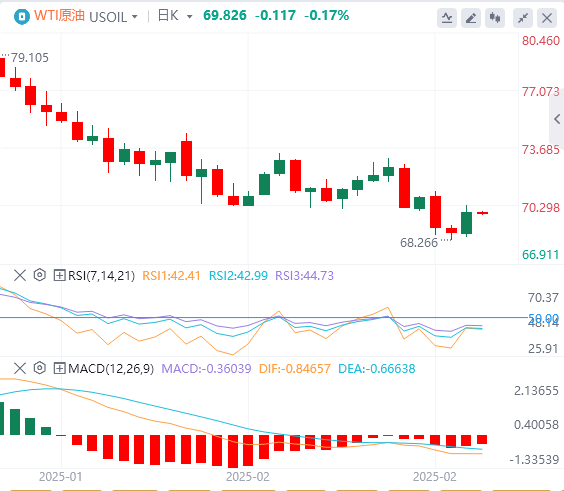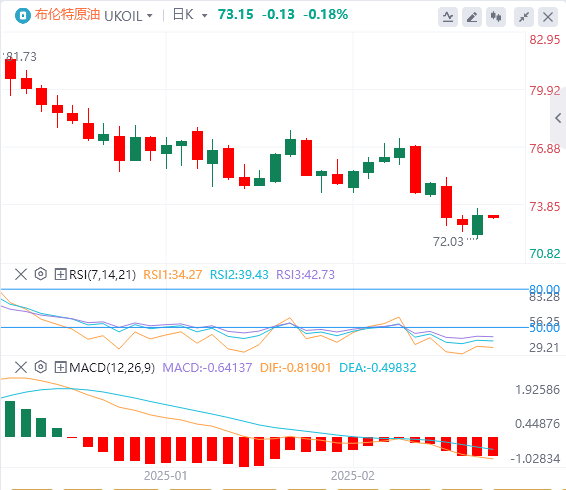Crude oil prices are on track for their first monthly decline since November as concerns about global economic growth and fuel demand outweigh supply worries amid Washington's tariff threats and signs of a slowing U.S. economy. WTI crude was quoted at $69.82 and Brent crude was quoted at $73.15.


Trump made it clear that tariffs on Mexico and Canada will be implemented on March 4, and said that reciprocal tariffs will be implemented on April 2; the Canadian Prime Minister responded: If the US tariff policy is implemented, it will respond strongly immediately. As for the UK, Trump said that if a trade agreement is reached, there is no need to impose tariffs on the UK.
Trump: Will try to win back as much land as possible for Ukraine; Putin: Russia and the United States are ready to re-establish a cooperative relationship; Trump will meet with Zelensky at midnight Beijing time on Saturday.
Israel and Hamas have begun negotiations on the next stage of the ceasefire in Gaza.
Source: Uncertainties about sanctions and tariffs remain, and OPEC+ is hesitant to increase production in April.
Although the threat of a 10% tariff on Canadian crude oil in early March is imminent, Trump once again stated yesterday that the tariffs will "go ahead as planned", which has strengthened market concerns. However, the crude oil market does not seem to be nervous about this at present. The WTI crude oil risk reversal indicator is at its lowest level in nearly five months, and WTI and WCS prices are also close to the lows of the past two months.
The most immediate impact of this move will be higher costs for U.S. consumers of petroleum products. This impact could be further amplified if the Canadian government takes countermeasures such as imposing export tariffs, partially reducing supply, or both. Therefore, we believe that the motivation for both sides to reach a political solution will be very strong.
Although the final decision will be made at the political level, understanding the actual supply and demand of the oil market is crucial to assessing the impact of a potential tariff war. Within the medium tariff range currently being discussed, we do not expect the adjustment of crude oil imports and exports to be large. However, if tariffs are further increased, U.S. refineries may reduce demand for Canadian crude oil and seek to increase supply from other sources. In this case, even if the quality of the alternative crude oil is different, we still believe that this move will bring direct benefits to major crude oil varieties such as WTI and Brent.
The outlook for reduced oil demand is unlikely to change anytime soon, which could prevent OPEC from starting to unwind its production cuts, further weakening its influence in global oil markets. However, the U.S. is far from being China’s only, or even its largest, supplier of crude oil. China may import less oil from the U.S. while tariffs last, but will most likely increase imports from other sources.
While this growth appears to be slowing, at the same time, growth prospects elsewhere appear bright, judging by recent news reports that BP is abandoning its energy transition targets and focusing again on oil and gas. This is increasingly likely as the transition has struggled over the past few years and there is no sign of change in sight. The world will need more oil for longer, and non-OPEC countries may not be able to meet this growth.
As a result, OPEC+ is not really at risk of losing market share in the foreseeable future, as they still account for more than 40% of total global oil supply - and U.S. shale is no longer growing at an alarming rate, regardless of oil prices, and OPEC+ still has the lowest production costs in the world.
Finally, it is worth noting that OPEC has not yet used its last resort - flooding the market with oil to deal with competition. This option may be very painful for it, but it does not mean that it will not happen.
Crude oil rebounded from trendline support after falling 15%. A sustained break above $71.77 could strengthen bullish momentum before entering a higher potential resistance zone.
On Thursday, crude oil broke through Wednesday's high, triggering a one-day bullish reversal. At the time of writing, the day's high is $70.79. Trading is still close to the day's high and a new high may be set before the market closes. Today's rise came after a bearish retracement potential bottom at yesterday's low of $68.63.
Note that the support for the bearish correction is at the rising trendline of the consolidation pattern lows established in the last few months of last year. Still, further bullish signs are needed, and before that, $68.63 could still be breached.
Trendline support emerged after a 15% decline. Potential support near this trendline was discussed previously as a price area that could end the bearish correction. In other words, this would be a possible location to see strong support signs. Even if the trendline fails to hold support, yesterday's low was a decline of $12.13 or 15% from the recent swing high of $80.76. Of course, the decline is closer to the end than the beginning. Therefore, unless the bearish momentum expands, a break below the trendline may not go too far.
Yesterday, Trump said he would revoke the license that his predecessor Biden's administration granted Chevron to operate in Venezuela more than two years ago. Chevron's Venezuelan operations export about 240,000 barrels of crude oil per day, more than a quarter of Venezuela's total oil production. The cancellation of the license means Chevron will no longer be able to export Venezuelan crude.
The Venezuela news triggered liquidation following recent selling during ceasefire talks between Russia and Ukraine. Potential buying in the U.S. Strategic Petroleum Reserve also supported the market as WTI crude oil prices approached their lowest level in more than two months.